Mount Magnet Gold Exploration Project
Location and Access
The township of Mount Magnet is located 500km north-northeast of Perth, Western Australia along the sealed Great Northern Highway.
Background
Ramelius holds title to over 16,200 ha of contiguous land tenure over the larger (+6Moz Au) Mount Magnet gold camp having acquired the project off Harmony Australia in July 2010.
Geology and Mineralisation
Regionally the Mount Magnet gold camp occupies the Meekatharra-Wydgee Greenstone Belt of the Murchison Province in the Western Australian Yilgarn Craton. The greenstone belt is dominated by the basal Luke Creek Group of supercrustal rocks bound by north-south trending foliated recrystallised monzogranite batholith rocks. Watkins and Hickman (1990) (1) describe the Luke Creek Group to consist of four formations comprising two volcanic sequences, one dominated by tholeiitic and komatiitic basalt, banded iron formations and interlayered mafic rocks and the second dominated by ultramafic intrusive volcanic complexes, interlayered tholeiitic and komatiitic basalt, plus mafic and felsic volcanic rocks and associated sedimentary rocks plus banded irons.
The detailed local geology of the Mount Magnet Gold Camp has been described in Thompson etal (1990) (2). Over 80% of the ore discovered and mined at Mount Magnet is banded iron formation hosted, dominated by the 2.1Moz Hill 50 gold mine while the balance is quartz vein hosted within mafic and felsic volcanic to volcaniclastic rocks. At Morning Star (>1Moz Au mined) mineralisation is hosted by quartz-carbonate + stibnite + molybdenite veins that occur in a series of deformed mafic volcanics, subordinate sediments and felsic intrusive rocks (3).
The dominant banded iron formations (bars) at Mount Magnet are referred to as the Sirdar Formation and host the majority of gold mineralisation (Galaxy Mining Area including Hill 50) within the gold camp. They consist of alternating laminae of quartz, iron oxides and carbonate, recrystallised during regional greenschist facies metamorphism. Gold mineralisation within the bars typically occupies steeply plunging pipe-like shoots with pyrrhotite replacing the magnetite facies iron formation within a series of cross cutting 030-0400 subvertical dipping “Boogardie Breaks” fractures. The bars juxtapose the outer margins of the Boogardie Formation (colloquially referred to as the Boogardie Basin) and are suggested to drape off the Boogardie Basin. Facing indicators by previous workers (Thompson etal) identified the Sirdar Formation faces away from the Basin throughout the district. Subsequent interpretations suggested the two dominant bars, the Saturn and Hill 50 bars, are isoclinally folded equivalents based upon the mapped distribution of hangingwall and footwall mafic plus ultramafic units within the Mars, Saturn and Perseverance pits. The current school of thought is the bars are east facing thrust duplexes of the same stratigraphic units.
In the footwall of the Sirdar Formation the Boogardie (Formation) Basin is dominated by talc carbonate altered ultramafic (komatiitic) flow sequences and peridotitic sills. The ultramafic rocks are intruded by domal felsic dacite to rhyolitic porphyry intrusions. Thompson etal (1990) estimated the Boogardie Formation to be 1.5 to 2km thick. This is supported by Ramelius’ gravity inversion modelling which suggests continuous thicknesses of denser ultramafic rocks may extend beyond the 1km depth limit of its 3-D geological model. Recent exploration by Ramelius has mapped three discrete domal felsic porphyry bodies intruding into the basal ultramafic pile, colloquially referred to as the Milky Way, Boomer and Mods Well (south of Lone Pine) porphyries. Alteration and deformation has destroyed most of the original porphyritic textures but multiple phases of pre, syn and post mineralising porphyries have been recorded throughout the gold camp during various drilling campaigns.
The Poverty Flats Formation overlies the Sirdar Formation east of the Galaxy Mining Area but remains poorly understood due to the paucity of significant bedrock gold mineralisation. The formation has basal ultramafic flows to the west overlain by mafic flows and tuffs and discontinuous Poverty Flat iron formations in turn overlain by further mafic flows and tuffs.
The Vicqueries Formation hosts the Morning Star, Water Tank Hill and St George deposits. The base of the formation is hosted by the pillowed tholeiitic basalt, overlain by the Evening Star Chert (now suggested to be the stratigraphic equivalent facies variant of the Black Cat South Shales/Chert, Paris Bar and Water Tank Hill Bar. Felsic polymictic breccia overlie the Evening Star Chert and Water Tank Hill Bar and consistently face east based upon graded bedding observations in diamond drill core (Thompson etal). The Morning Star Basalt is reportedly an east facing pillowed tholeiitic basalt (Thompson etal). Of contention is whether the reported southeast facing Nathan Chert, where exposed in the Nathan pit, is the folded strike extension of the Evening Star Chert or a thrust duplexed equivalent to the Evening Star Chert.
Various workers have suggested the Evening Star and Nathan Cherts are fold repeated equivalents, with the Morning Star Basalt occupying the core of the doubly plunging Morning Star Syncline. By extrapolation the Water Tank Hill and St George Bars would also represent fold repeats, with Water Tank Hill plunging 700 northwards in a synformal fold. Additional facing indicators need to be collected/interpreted during ongoing exploration and mining to fully understand the inter-relationships between the various cherts/bars. Complicating the picture, the various cherts/bars are stoped by felsic porphyry intrusions between Morning Star and Water Tank Hill/St George making any definitive interpretation on continuity conjectural for now. Felsic volcanics, tuffs and agglomerates sit at the top of the Vicqueries Formation further to the east.
Overlaying the Vicqueries Formation is the Mistico Formation, dominated by coarse grained polymictic clastic sediments. The Mistico Formation also remains poorly understood but is interpreted to unconformably overly the mafic/ultramafic/banded iron stratigraphy of the Vicqueries and Sirdar Formations. The eastern margin of the Mistico Formation is bound by the Lennonville Fault, a north-south trending fault/shear zone that controls the distribution of a number of small gold deposits along its strike within the northern half of Ramelius’ land package, ultimately heading northwards towards the Blackmans deposit and further north towards the township of Cue.
The greenstone belt at Mount Magnet is intruded by a series of late stage domal granitoids including the Jumbulyer Granite to the south of the gold camp. The Jumbulyer Granite is in turn truncated by the north east trending Jumbulyer Fault, that passes immediately south of the Mount Magnet township. The western side of the gold camp is truncated by a north-south trending shear zone (Wattle Creek Fault) showing intercalated blocks of sheared granite and greenstone rocks.
The Latercomer Fault passing through the Morning Star deposit and the Hill 50 Fault terminating the Hill 50 underground mine also run northeast and parallel the Jumbulyer Fault. Approximately 500m of dextral strike-slip movement is inferred along the Jumbulyer Fault, while sinistral displacement up to 180m is inferred along the Latecomer Fault. At Hill 50 the mineralised Hill 50 Bar is sinistrally displaced over 200m, where the northern extension of the bar dominates the mineralisation within the Mars pit.
Both the Hill 50 and Latercomer Faults are interpreted as long lived, deep seated, mantle tapping structures reactivated by the last deformation event affecting the rocks at Mount Magnet. They are believed to be important for localizing the gold mineralisation throughout the camp and remain a key focus for ongoing exploration. A swarm of dextral and sinistral displaced axial planar faults are also observed to disrupt the continuity of the bars throughout the Sirdar Formation. These are late, post mineralising faults and are not recognised to control the localisation of any gold mineralisation within the camp.
(1) Watkins and Hickman (1990): Excursion No. 2 Murchison granite-greenstone terrain in Third International Archeaen symposium, excursion guidebook (Ed. SE Ho etal) UWA Geology Key Centre and University Extension pp145-201
(2) Thompson etal (1990): Gold Deposits of Hill 50 Gold Mine NL at Mount Magnet, in AUSIMM Monograph 14 – Geology of the Mineral Deposits of Australia and Papua New Guinea (Ed. FE Hughes) pp221-241
(3) Mason etal (2000): Geology and Structure of the Morning Star Mine, Mount Magnet, WA in 4th International Mining Geology Conference pp143-154
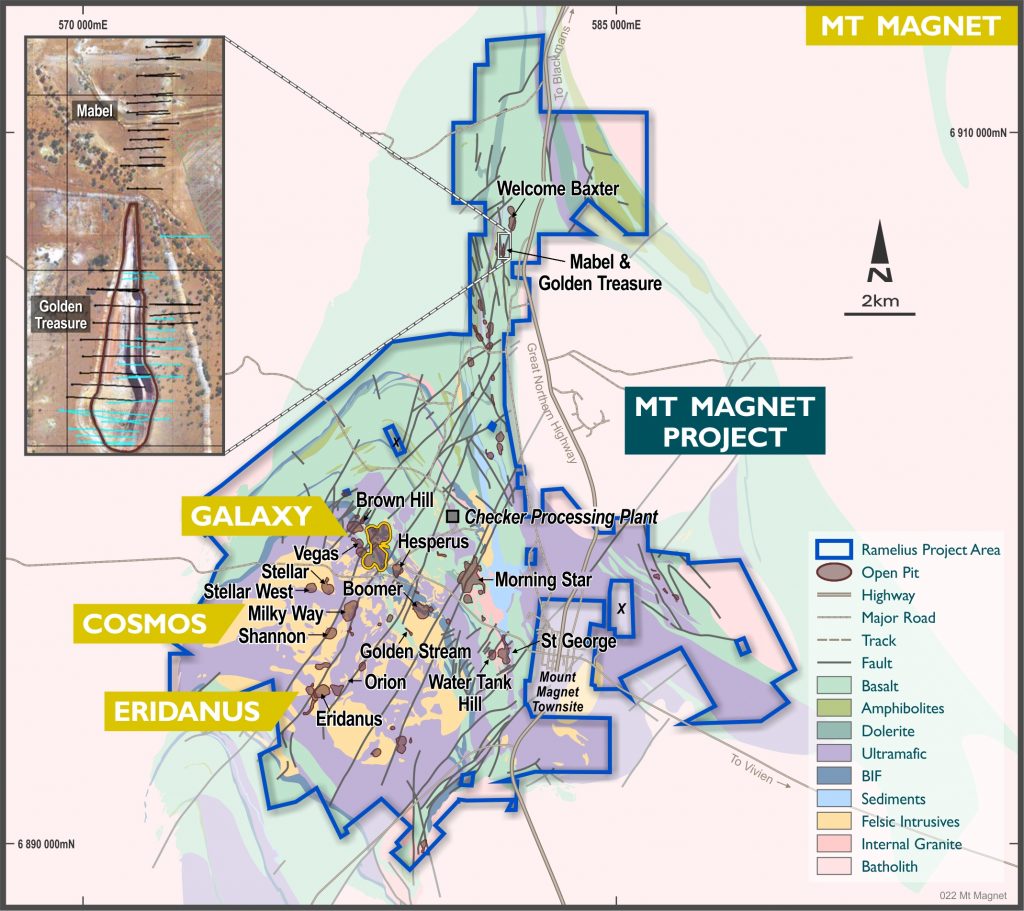
Location of Mabel and Golden Treasure prospects north of the Checkers Mill
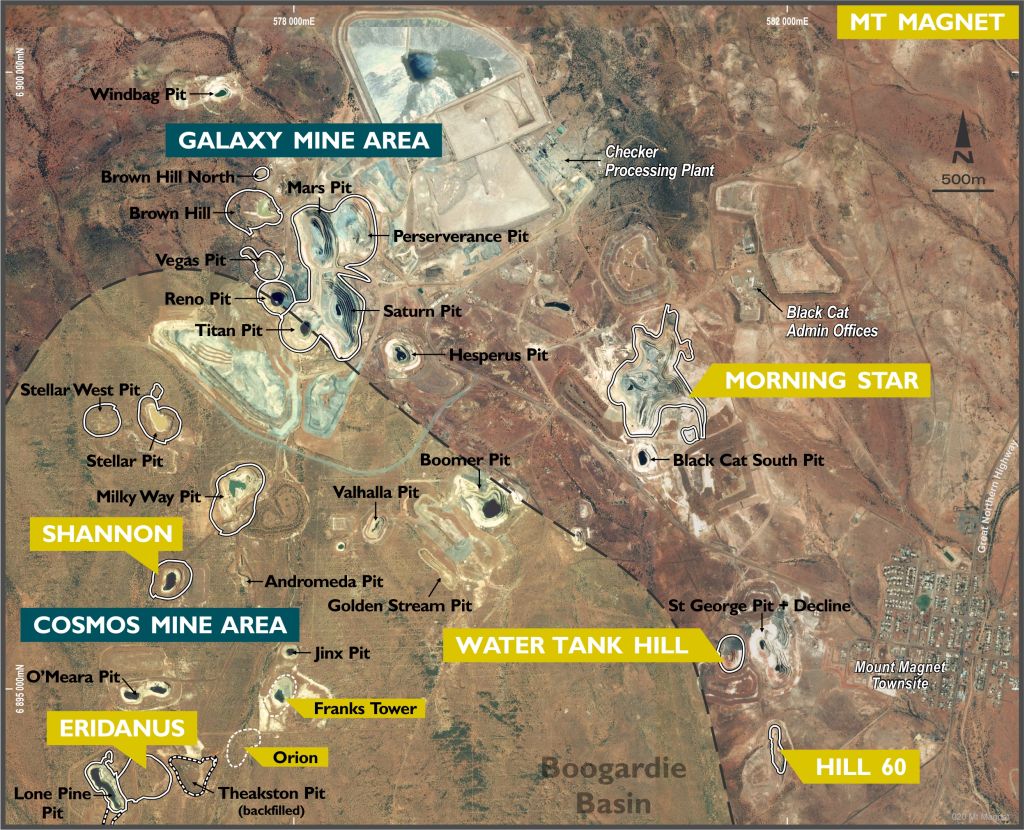
Mt Magnet key mining & exploration areas
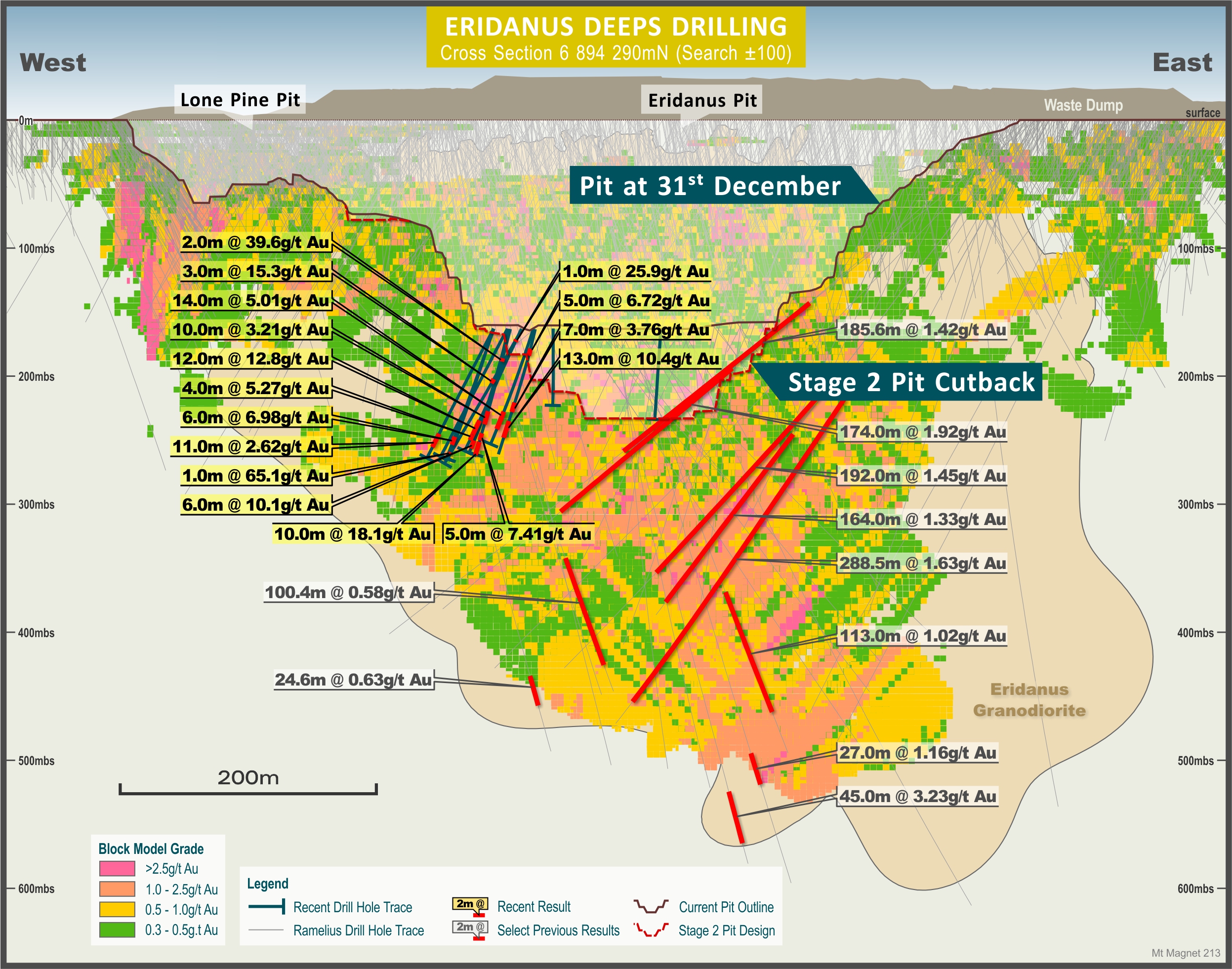
Selected Eridanus Deeps diamond drill hole traces below Stage 2 cutback pit design
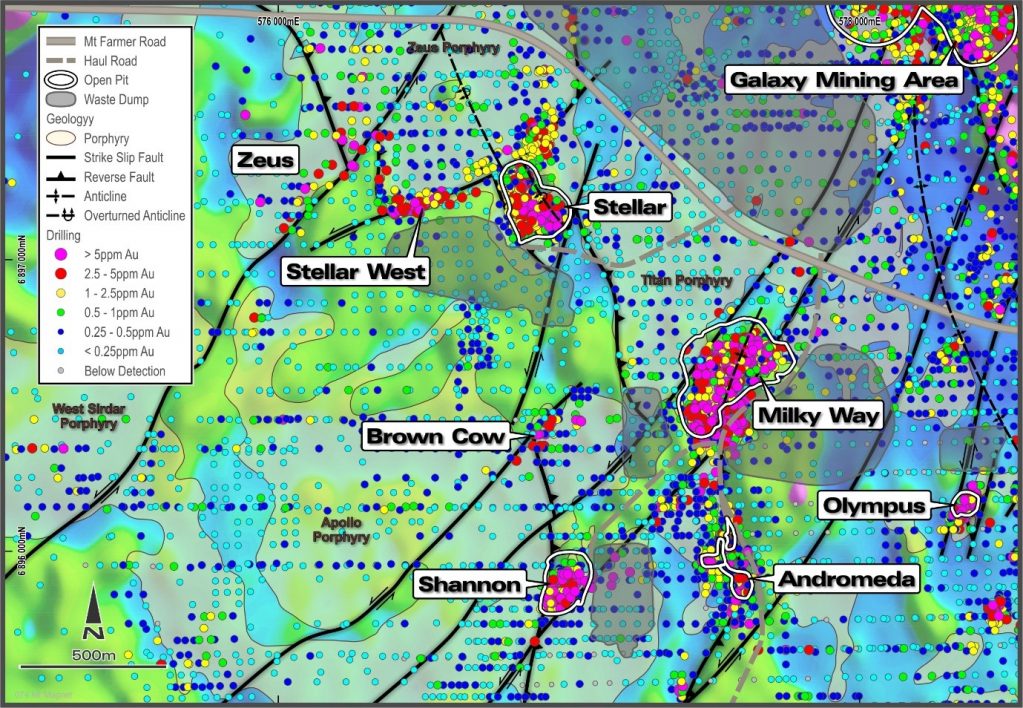
Plan view of the Boogardie Basin porphyry model draped over a TMI aeromagnetic image and highlighting the area between Shannon, Milky Way and Stellar. Historical drilling is deemed to have been ineffective and the identification of newly discovered high grade shoots occurs along the confluence of shears/fault trends
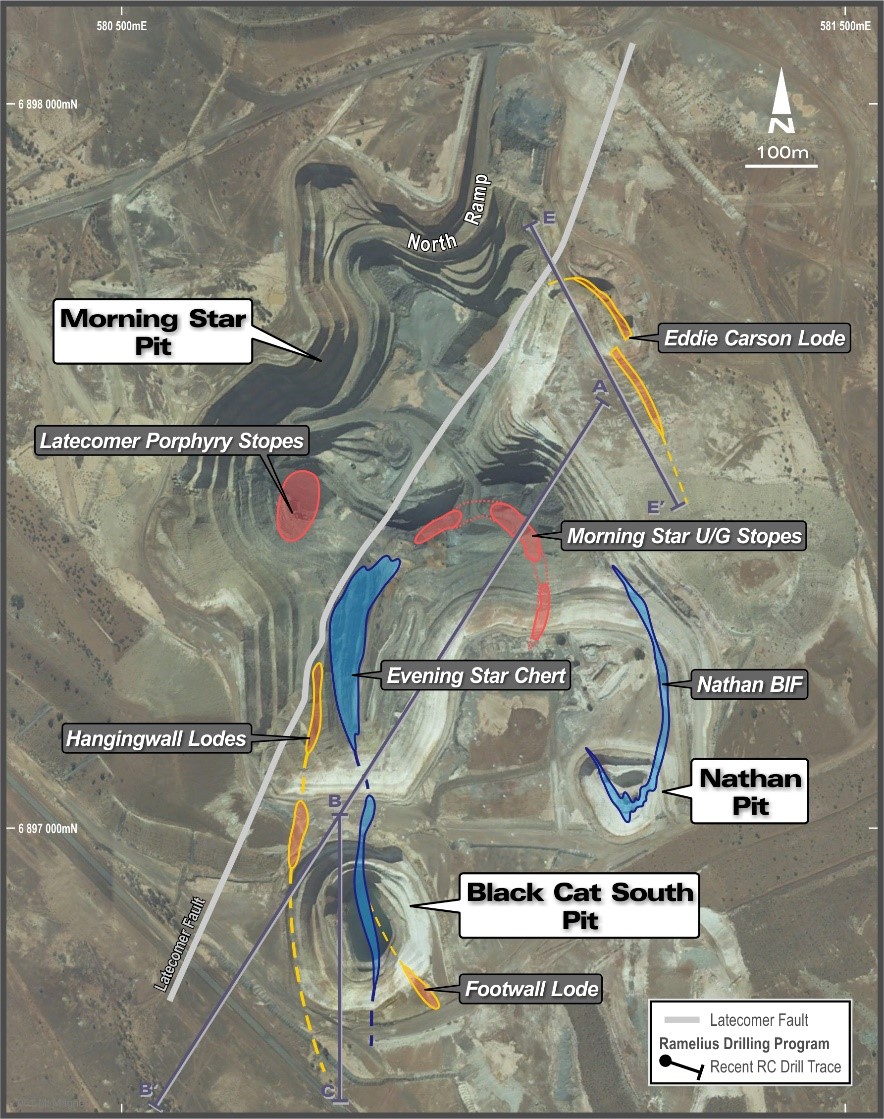
Morning Star and Black Cat South open pits showing the location of various mineralised lodes/BIF trends
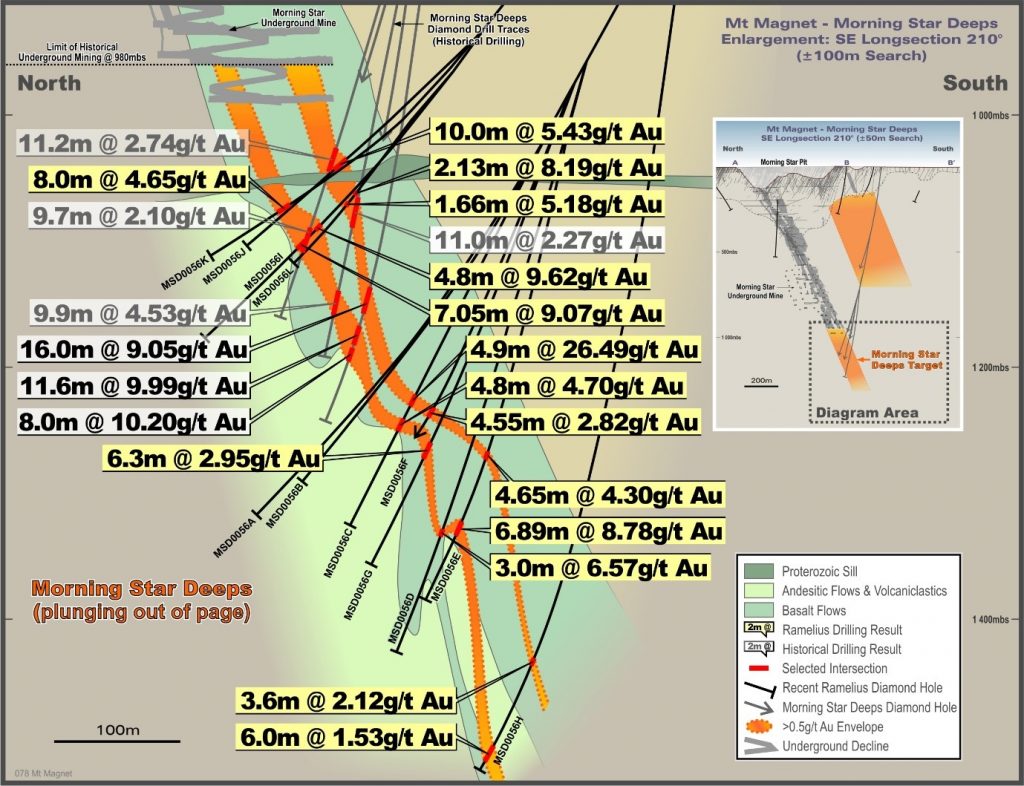
Morning Star – north-south longitudinal section (looking south-east) orthogonal to the plunge of the Morning Star underground mine (historically mined to 980mbs) and highlighting the deeper underground exploration results below the current mine. Mineralisation remains open with depth
